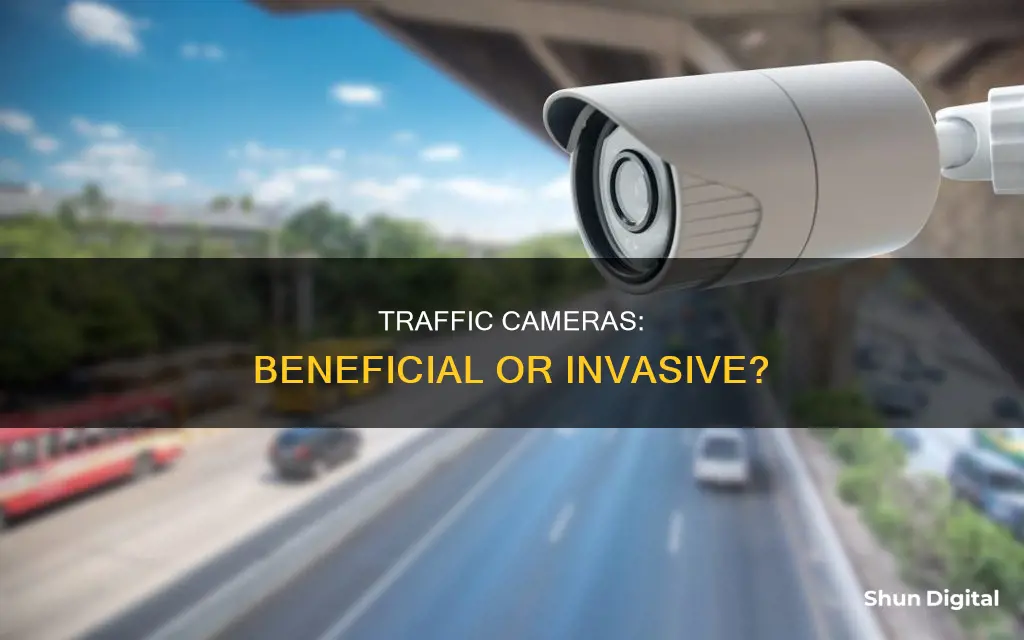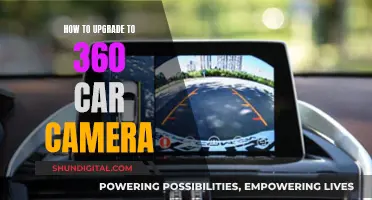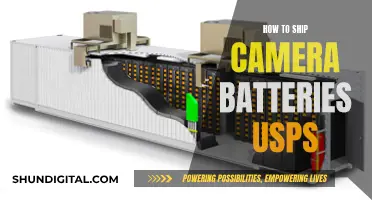
Traffic cameras are a highly debated topic, with some people arguing that they are an invasion of privacy, while others believe they are necessary for road safety. Traffic cameras are cameras mounted beside or over a road or installed in an enforcement vehicle to detect and prevent motoring offenses, including speeding, running red lights, and unauthorized use of bus lanes. They can also be used to monitor traffic flow and help with road development and construction. While some people argue that traffic cameras are an effective way to improve road safety and reduce accidents, others claim that they are simply a way for local governments to increase revenue through fines.
| Characteristics | Values |
|---|---|
| Crime prevention | Cameras can be used to prevent crimes such as illegal dumping and dangerous driving. |
| Crime investigation | Cameras can be used to investigate crimes, such as traffic violations and accidents. |
| Traffic flow | Cameras can be used to monitor traffic flow and provide data to improve it. |
| Data gathering | Cameras can be used to gather data on traffic patterns, including peak times and accident hotspots. |
| Worker and equipment safety | Cameras can be used to monitor temporary road construction sites and protect workers. |
| Safety | Cameras can help to prevent dangerous accidents and reduce speeding. |
| Evidence | Cameras can provide valuable evidence in the event of an accident or traffic violation. |
| Insurance | Cameras can help to reduce insurance rate hikes after accidents. |
| Cost savings | Cameras can help to reduce the costs of court cases by providing clear evidence. |
What You'll Learn

Traffic cameras can help prevent dangerous accidents
Traffic cameras are an increasingly common feature of roads and intersections across the world. While they are often controversial, there is evidence to suggest that they can help prevent dangerous accidents.
One of the main ways that traffic cameras can reduce accidents is by acting as a deterrent. When drivers are aware of the presence of monitoring cameras, they are less likely to break distracted driving laws, thus reducing the risk of accidents caused by driver error. This was supported by a study in Virginia which showed that red light cameras reduced the number of drivers running red lights by 67%.
In addition to acting as a deterrent, traffic cameras can also provide valuable evidence in the event of an accident. This can help to prove fault and ensure that the responsible party is held accountable, as well as providing clarity for insurance companies and reducing the risk of insurance fraud.
While some sources argue that red light cameras do not improve public safety and may even increase accidents, particularly rear-end collisions, other studies have found that speed cameras, in particular, are effective at reducing accidents and injuries. For example, a worldwide review of studies found that speed cameras led to a reduction of 11% to 44% in fatal and serious injury crashes. Similarly, the UK Department for Transport estimated a 22% reduction in personal injury collisions and 42% fewer people being killed or seriously injured at camera sites.
Overall, while traffic cameras may not always reduce the total number of accidents, they can play a crucial role in preventing dangerous accidents and ensuring that those responsible are held accountable.
How License Plate Readers Are Catching Speedsters
You may want to see also

They provide valuable evidence
Traffic cameras can provide valuable evidence in a variety of situations. One of the most significant uses of traffic camera footage is in car accident cases, where it can help determine the cause of the accident and establish fault and liability. This type of evidence is especially useful in intersection car accidents, which often involve multiple vehicles, pedestrians, and cyclists. With so many variables at play, it can be challenging to reconstruct the events leading up to the collision. Traffic camera footage offers an objective, unbiased view of the incident, capturing critical details such as the position and speed of vehicles, as well as any traffic violations that may have occurred.
In addition to car accident investigations, traffic camera footage can also be used to investigate and prevent crimes. Cameras placed at busy intersections or along highways can assist law enforcement in monitoring traffic patterns, gathering data, and identifying potential hotspots for traffic violations or criminal activities. The presence of these cameras can also act as a deterrent to dangerous driving and help encourage safer driving habits.
Furthermore, traffic camera footage can be invaluable in insurance disputes. It can help prove that a driver was not at fault in an accident, preventing unfair insurance rate hikes and protecting drivers from unjust financial burdens. This is particularly relevant given the increasing prevalence of distracted driving due to mobile phone use.
When it comes to legal proceedings, traffic camera footage can be admissible in court, although this may vary depending on the jurisdiction. In most states, this type of footage is considered valuable evidence, especially when supported by the testimony of witnesses. However, there may be challenges to its admissibility, such as concerns over privacy rights or the accuracy and reliability of the technology.
To obtain traffic camera footage for legal purposes, one must act quickly and follow the proper procedures. The process can be complex, and it is advisable to seek the help of a qualified attorney who has experience in navigating the specific laws and regulations pertaining to traffic camera evidence in their respective state.
iMac Camera Location: Where is the Camera?
You may want to see also

They can help challenge insurance rate hikes
Traffic cameras can be incredibly beneficial when it comes to challenging insurance rate hikes. They can provide valuable evidence to protect drivers from steep insurance hikes after accidents, even when they are not at fault.
How Traffic Cameras Can Help
Traffic cameras can be used to prove that an accident was not the driver's fault. This is especially useful when facing insurance companies, which have teams of lawyers and access to data that the average driver does not. With traffic camera footage, drivers can prove their innocence and dispute their fault, reducing the likelihood of a rate hike.
Reducing Insurance Costs
Insurance companies are known for increasing rates after accidents, even if the driver was not at fault. Traffic camera footage can be used to prove that a driver was not at fault, helping them avoid a rate hike altogether. This is significant, as some insurance companies may charge up to 16% more on insurance premiums, even for not-at-fault accidents.
Peace of Mind
Traffic cameras can provide valuable peace of mind for drivers involved in accidents. They can show exactly what happened from a bird's-eye view, removing any doubt or confusion caused by conflicting accounts. This can be crucial in understanding the events leading up to an accident and determining fault.
Recouping Diminished Value
In addition to repair costs, accidents can reduce the value of a vehicle by as much as 30%. Traffic camera footage can help drivers recoup this diminished value by proving fault and enabling them to collect compensation for the full extent of their losses.
Cutting Costs
When a driver is not at fault in an accident, they may still face the burden of legal fees and court costs. Traffic camera footage can provide airtight evidence of what occurred, allowing drivers to prove their case quickly and avoid costly litigation.
Traffic cameras are a valuable tool for challenging insurance rate hikes. They provide indisputable evidence, protect drivers from unfair rate increases, and help drivers recoup losses and cut costs. By utilising traffic camera footage, drivers can better protect themselves from the financial consequences of accidents.
Rigging Cameras in Cars: Techniques and Challenges
You may want to see also

They improve traffic flow
Traffic cameras are placed strategically in various locations such as complex intersections, roads with traffic congestion, or areas with extreme weather. They are typically mounted on poles, bridges, or other structures and are usually placed at intersections, on-ramps, and other points with heavy or congested traffic.
Traffic cameras are beneficial in improving traffic flow in several ways. Firstly, they provide real-time monitoring of traffic conditions, allowing authorities to detect traffic congestion and take appropriate action. This helps to keep roads from being congested and improves traffic safety. For example, traffic cameras can be used to control traffic lights based on the current traffic situation, optimising traffic flow.
Secondly, traffic cameras can be used to gather data on traffic patterns, including details of peak traffic times and accident hotspots. This data can then be used to inform future road development and construction work, leading to improved road infrastructure and traffic flow.
Additionally, traffic cameras with advanced analytics can detect and classify objects, people, or vehicles in real-time, providing valuable information to authorities. For instance, they can be used to identify vehicles travelling in the wrong direction on a highway, allowing for immediate action to prevent accidents.
Furthermore, traffic cameras can be linked to adaptive traffic signalling systems. When a camera detects a problem, such as a stationary vehicle, it can send an alert to the system, which can then warn other drivers, improving traffic flow and safety.
Lastly, traffic cameras can help reduce vehicle emissions by optimising traffic flow and enforcing speed limits, leading to reduced fuel consumption and carbon emissions.
Overall, traffic cameras play a crucial role in improving traffic flow by providing real-time data, advanced analytics, and adaptive signalling capabilities, resulting in safer and more efficient roads.
Access Cox Cameras on Your Computer: Easy Steps
You may want to see also

They can help prevent crime
Traffic cameras can be beneficial in preventing and solving crimes. They can be used to monitor traffic flow and identify vehicles involved in criminal activities, such as speeding, running red lights, or illegal dumping. For example, in Baltimore and Chicago, cameras were linked to reduced crime rates, even beyond the areas with camera coverage. Additionally, footage from traffic cameras can be used as evidence in court cases, helping to prove innocence or guilt.
The presence of traffic cameras can also act as a deterrent to criminal activities. For instance, drivers who are aware of the cameras are less likely to violate distracted driving laws, thus reducing the risk of accidents. Similarly, the presence of cameras at intersections and along highways can encourage safe driving habits and discourage moving violations.
The use of traffic cameras for crime prevention and investigation provides valuable benefits to law enforcement agencies and government departments. The footage captured by these cameras can be monitored in real-time or recorded for later review, providing a unique level of situational awareness. This technology can also be integrated into various law enforcement activities and used in conjunction with traditional police work to solve crimes and ensure public safety.
While some may raise concerns about privacy invasion, it is possible to implement and use surveillance cameras responsibly while still respecting civil liberties. Guidelines and policies can be put in place to address privacy issues, such as avoiding or masking views of private areas. Additionally, proper training and accountability measures for law enforcement officers can help ensure the appropriate use of surveillance camera systems.
Fight Camera Speeding Tickets: Your Legal Defense Strategy
You may want to see also
Frequently asked questions
Yes, traffic cameras are beneficial to road safety. They act as a deterrent to dangerous crashes, with drivers who are aware of monitoring cameras being less likely to violate distracted driving laws. They also provide valuable evidence in the event of an accident, helping to prove who is at fault.
Traffic cameras can be placed at common congestion points to provide information on the causes and severity of poor traffic flow. This data can then be used to improve traffic management and reduce congestion.
Traffic cameras have been criticised for their potential to be used for mass surveillance of vehicle movements and, by association, the movements of vehicle owners. This has raised concerns about privacy and government overreach.







